Key takeaways:
- Homelessness charities address immediate needs and highlight the complexity of factors contributing to homelessness, such as mental health, substance abuse, and economic instability.
- Local advocacy is vital for cultivating community engagement and fostering understanding between residents and policymakers, which can drive meaningful change.
- Effective advocacy includes forming partnerships with local businesses and utilizing social media to amplify voices and raise awareness about homelessness issues.
- Listening and sharing personal narratives are crucial in advocacy work, as they build empathy, solidarity, and inspire others to participate in community efforts.
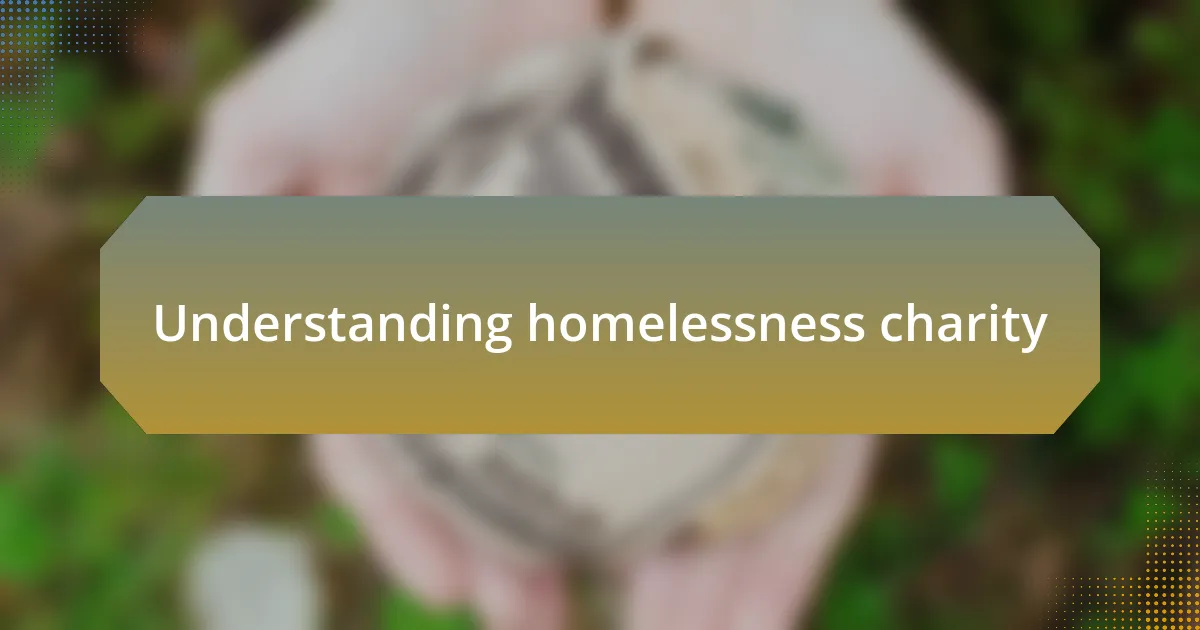
Understanding homelessness charity
Homelessness charities play a crucial role in addressing the immediate needs of those without stable housing. Personally, I’ve witnessed the transformative power of these organizations when I volunteered at a local shelter. The gratitude on someone’s face after receiving a warm meal or a warm place to sleep is unforgettable—could there be a more genuine testament to the importance of these charities?
Moreover, it’s essential to realize that homelessness isn’t just about lack of shelter. Often, it involves a complex interplay of factors such as mental health issues, substance abuse, and economic instability. I remember a young man I met, who had a steady job but fell behind due to a medical emergency. How often do we overlook that a single setback can spiral into larger hardships for anyone?
Engaging with homelessness charities has taught me that we all share a responsibility in this fight. When we donate, volunteer, or even advocate for local solutions, we help restore dignity to those experiencing homelessness. Isn’t it heartening to think that, together, we can make a difference in someone’s life, one small act at a time?
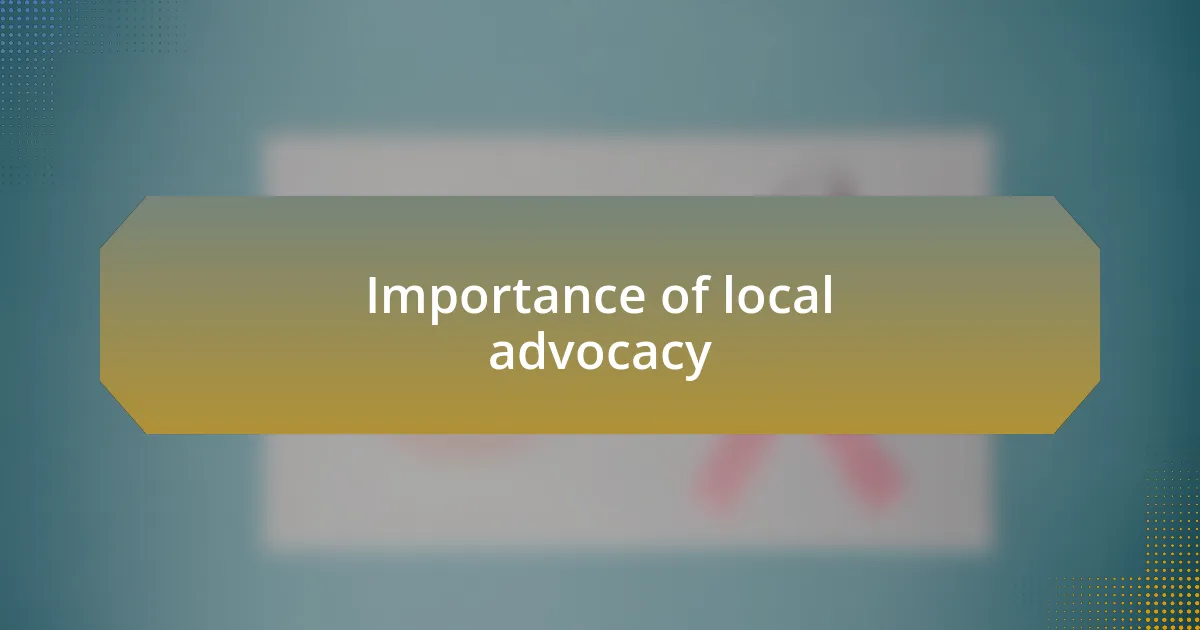
Importance of local advocacy
Local advocacy is essential because it creates a direct connection between community members and the unique challenges they face. I remember attending a town hall meeting where residents voiced their concerns about a recent increase in homelessness in our area. It was eye-opening to see how local voices could resonate with policymakers and inspire real change.
Being present in advocacy efforts gives a firsthand perspective on the needs of the homeless community. I once organized a neighborhood clean-up that included local residents and those experiencing homelessness. The conversations that unfolded during that event helped me understand individual stories behind the statistics, making it clear that localized efforts can foster understanding and compassion.
Furthermore, local advocacy empowers individuals to take ownership of their community’s issues. I still recall my initial hesitation to speak up at a local council meeting about housing policies. But once I shared my experience, the energy shifted; others began to share their stories too. Isn’t it incredible how by simply standing up and speaking out, we can spark a collective movement for positive change?
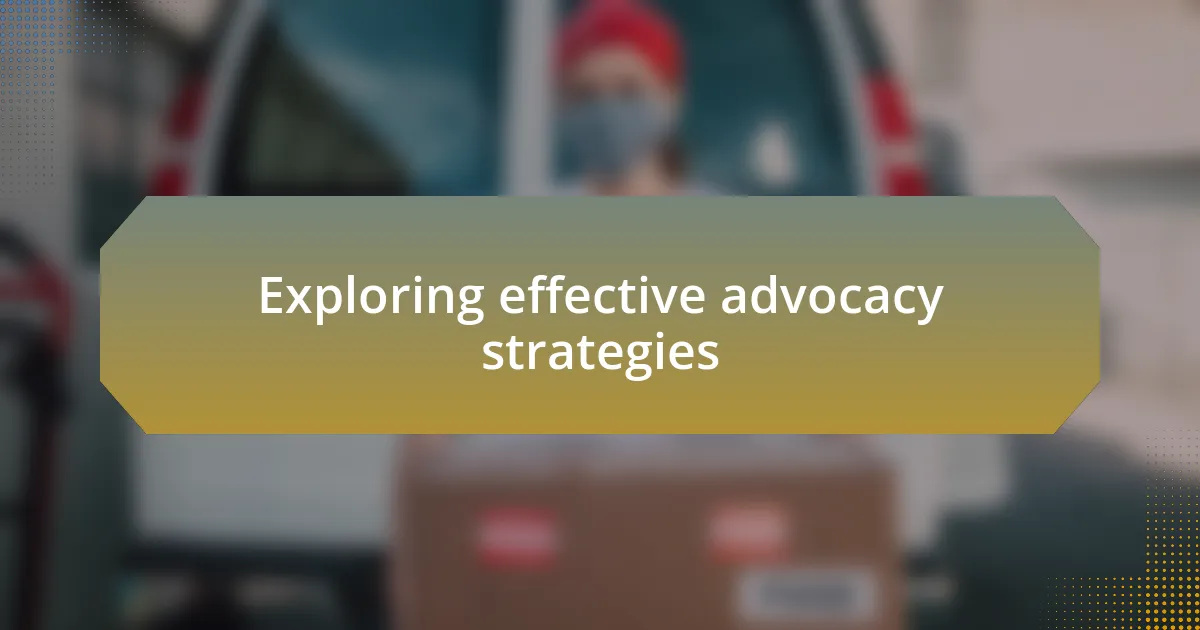
Exploring effective advocacy strategies
Advocacy requires a multifaceted approach to truly address the complexities of homelessness. One effective strategy I’ve found is forming partnerships with local businesses. For instance, during a community event, we collaborated with a local café to donate a percentage of their earnings to support a nearby shelter. This not only provided tangible resources but also created a platform for meaningful dialogue between service providers and community members, aligning our efforts with shared values.
Additionally, grassroots campaigns can be a powerful tool in amplifying local voices. I remember organizing a letter-writing campaign where we reached out to local officials about the lack of affordable housing options. The response from community members was overwhelming, and witnessing their passions fueled our shared mission. Have you ever felt the electric energy in a room when people unite for a common cause? It’s remarkable how collective action can spark attention and sway decision-makers.
Lastly, utilizing social media effectively can broaden the reach of our advocacy efforts. I once launched an online challenge encouraging individuals to share their experiences and insights about homelessness. The engagement was phenomenal, as personal stories flooded in, raising awareness and building empathy. Isn’t it fascinating how online platforms can bridge gaps and connect us in ways we never imagined? This strategy not only raises awareness but also fosters a sense of community, reminding us all that we’re fighting for the same cause.
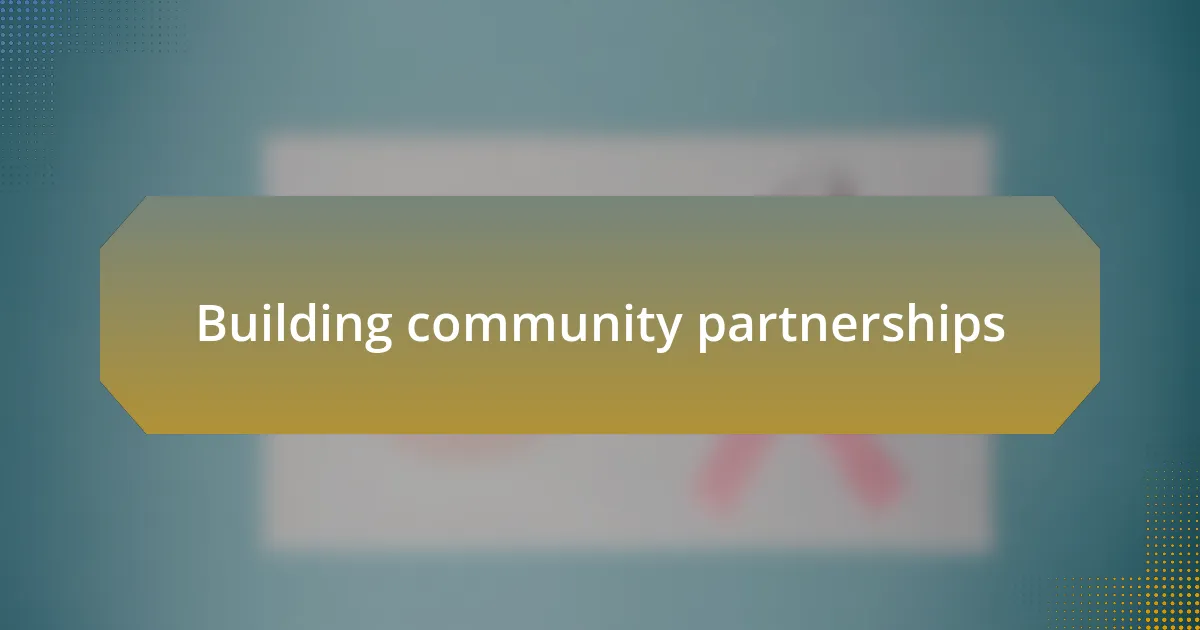
Building community partnerships
Building relationships with local organizations has been incredibly rewarding in our advocacy work. For example, I reached out to a nearby non-profit focused on job training for the homeless. Through our collaboration, we organized a workshop that not only taught valuable skills but also provided a much-needed support system for attendees. The energy in that room was palpable; you could feel hope mingling with determination. How often do we think about the synergy created when diverse groups come together?
In another instance, partnering with local schools allowed us to bring awareness to young minds about homelessness. Together, we organized a fundraiser where students created art pieces representing their vision of community support. The pride and creativity they displayed were awe-inspiring. Witnessing the students’ engagement made me realize how essential it is to involve various segments of the community, ensuring that the conversation about homelessness reaches all ages.
Lastly, fostering relationships with healthcare providers has been a game-changer for our advocacy. A partnership with a local clinic led to a health fair that provided free screenings and information to individuals experiencing homelessness. The gratitude on attendees’ faces was a reminder of how small efforts can make significant impacts. Have you ever considered how local collaborations can illuminate issues that might otherwise remain invisible? This kind of partnership showcases just how interconnected our communities truly are.
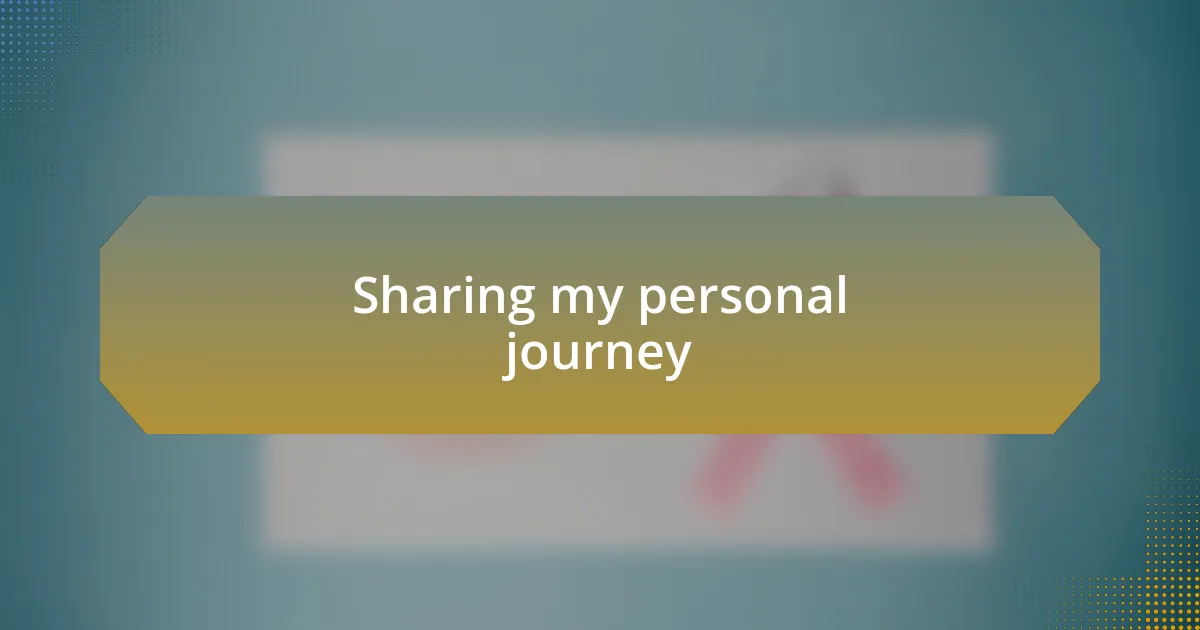
Sharing my personal journey
One of the most defining moments in my journey was when I first volunteered at a local shelter. I remember stepping inside, feeling a mix of anticipation and nervousness. It struck me how everyone was so eager to share their stories. I listened to a woman recount her experience with losing her home due to unforeseen circumstances. It made me realize that each individual has a narrative worth hearing. Have you ever stopped to think about the stories that our community members carry with them every day?
As I continued my advocacy work, I found myself becoming more than just a volunteer; I became a part of a larger movement. At a community gathering, I shared my own story about witnessing homelessness in my youth and the impact it had on my life. The response was overwhelming. People opened up, sharing their emotions and experiences. This connection emphasized for me the importance of vulnerability and authenticity in advocacy—by sharing our journeys, we foster a sense of solidarity. Isn’t it fascinating how shared experiences can elevate our collective empathy?
Looking back, I can see how those humble beginnings fueled my passion for local causes. Each encounter has shaped my understanding and deepened my commitment to advocating for change. For instance, when I helped coordinate a community mural project that depicted the themes of resilience and hope, I felt an immense sense of pride. The energy from everyone coming together—artists, families, and those experiencing homelessness—was a reminder that art can transcend barriers. Have you considered how creativity can be a powerful tool for advocacy?

Lessons learned from my experience
The most profound lesson I learned was the power of listening. I recall a day at the shelter when a young man, newly homeless, spoke about his struggles with mental health. As I sat there, absorbed in his words, I realized how often we overlook the silent battles individuals face. Isn’t it eye-opening to think that sometimes, all someone needs is a compassionate ear?
Another insight emerged from observing the ripple effects of small acts of kindness. One afternoon, a group of us decided to hand out care packages filled with essentials. The smiles we received in return were priceless and taught me that even simple gestures can restore dignity. Have you ever seen how a small offering can ignite hope in someone feeling invisible?
Finally, I’ve learned that advocacy is as much about self-care as it is about caring for others. I experienced burnout after pushing myself too hard during a fundraising campaign. It was a wake-up call that I needed to recharge to sustain my efforts for the long haul. How can we effectively support others if we are running on empty? This balance fosters resilience not only in our advocacy work but also within ourselves.
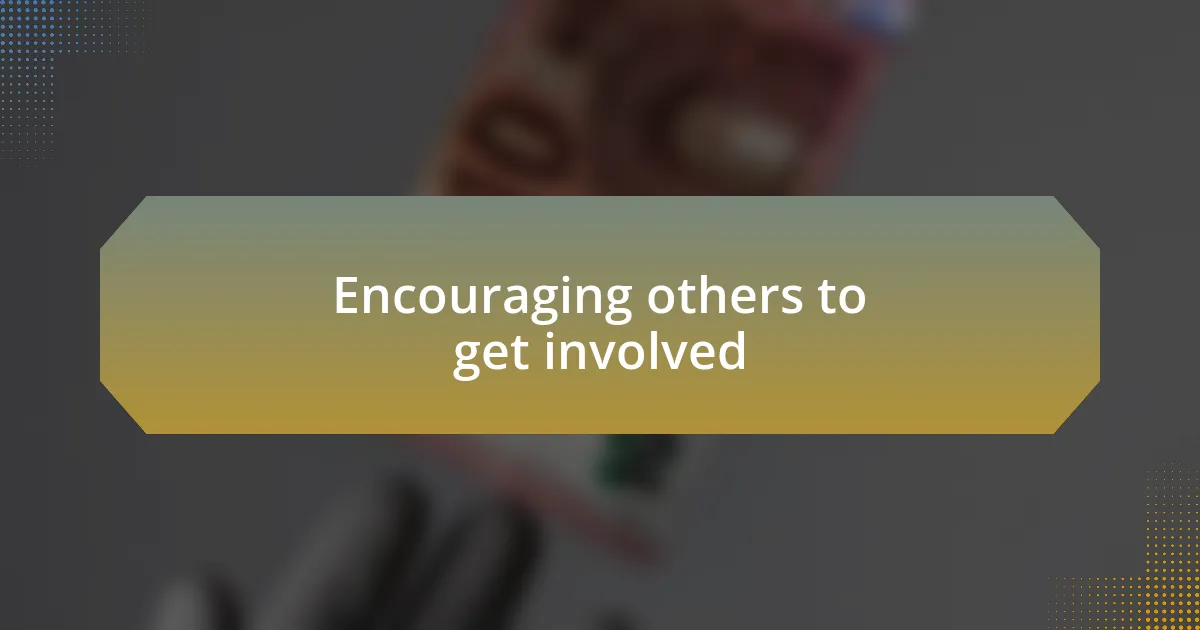
Encouraging others to get involved
When I think about the impact of advocacy, I realize that inviting others to join us amplifies the message. During a recent community event, I was amazed at how many individuals felt inspired to step up after hearing stories shared by those directly affected by homelessness. Isn’t it fascinating how personal narratives can ignite a spark in someone to take action?
I often encourage friends to volunteer alongside me because the experience is always transformative. One Saturday, I took a group to a local soup kitchen. Watching them connect with guests, sharing laughter and hope, shifted their perspective entirely. Have you ever witnessed someone’s heart open simply by getting involved? It’s truly a gift.
Moreover, creating a supportive environment for advocacy can be as simple as starting conversations. I routinely share my experiences on social media, sparking dialogues that encourage others to see the reality of our local homeless community. I find that when I expose the raw truths about their experiences, people are more willing to contribute their time or resources. Isn’t it amazing how awareness can lead to action?